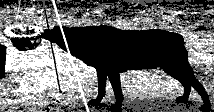Cooking "Clan of the Cave Bear" Style!
Final Thoughts
Rawhide is an amazing material. I even created a blade from it
with a serrated edge and used it to cut a tomato. It can be used
in the construction of shields, armor, boats, masks, drums, and
all manner of things (not forgetting that it can also be tanned
and made into leather), and as a binding is very strong and useful
in both construction and repair.
 However, most fascinating from an archaeological
perspective is that it is virtually invisible in the archaeological
record. Not only time and decay play a
role here in consideration of human artifacts. Rawhide is so
irresistible to dogs that anything discarded (and some things
no doubt even before they were willingly discarded) would have
been made short work of by camp or wild dogs.
However, most fascinating from an archaeological
perspective is that it is virtually invisible in the archaeological
record. Not only time and decay play a
role here in consideration of human artifacts. Rawhide is so
irresistible to dogs that anything discarded (and some things
no doubt even before they were willingly discarded) would have
been made short work of by camp or wild dogs.
But even if rawhide artifacts shone forth from the archaeological
record as brightly as stone, I doubt, based on the results
of this experiment, that we would find skin pots that had been
used for cooking over a fire. Neandertals and other hunter-gatherers
had better things to do with their time.
Refernces
Auel, Jean M. (1980) The Clan of the Cave Bear, Bantam Books
McParland, Pat (1977) Experiments in the firing and breaking of
rocks. The Calgary Archaeologist v.5, pages 31-33
Overstreet, Charles (1993) Plains Indian and Mountain Man Arts and Crafts, Eagle's View Publishing.
Wilson, Michael (1996) in conversation
| Neandertal Stew
(a la The Clan of the Cave Bear, pages 81,82) |
Ingredients:
bison (we substituted cow)
wild onion (substituted domestic)
unspecified herbs (chose marjoram, cloves, garlic, and bay leaf)
thistle stalks (we omitted)
mushrooms
watercress (substituted bamboo shoots)
small immature yams (substituted grocery store yam)
cranberries (substituted canned cranberry sauce with whole cranberries)
"wilted flowers from previous days growth of day lilies for
thickening" (substituted
potatoes)
Note on other substitutions from Elizabeth B. Naime (Feb, 1998)
Add meat first, then potatoes (if used), then softer ingredients which don't take as long to cook. You might want to have salt and pepper on hand as well. Auel used the adjective "salty" for coltsfoot (omitted, see below), and this may be what that ingredient was intended for [August 30, 1996, personal correspondence ~ Auel notes that the saltiness may actually be from a source where the coltsfoot was flavoured with ash.]
Some ingredients were omitted and not substituted for as my sister
Betty, wise in plant-lore herself, expressed skepticism about
some of them and looked them up. The roots of milkweed should
be avoided, and the other parts "must be boiled in three
or four different batches of water to remove toxic substances
and make them safe to eat." The cooking water should be
discarded (Magic and Medicine of Plants, senior editors
James Dwyre & David Rattray, 1986, published by Readers Digest
Association Canada Ltd.). The tome also mentioned that "coltsfoot
may cause cancer if taken in large doses or repeated small doses."
Betty also expressed some reservations about lilies, noting that
some varieties are poisonous. I should add that the mushrooms
we used were from the grocery store, and that anyone using wild
mushrooms they've picked themselves does so at their own risk.
[August 30, 1996 ~ further info
from Jean Auel.]
The Icons below will guide you to the other Cooking Clan of the Cave Bear Style Pages |